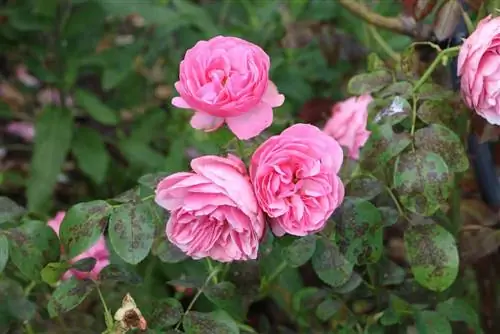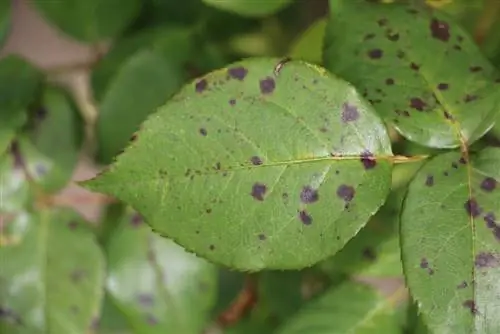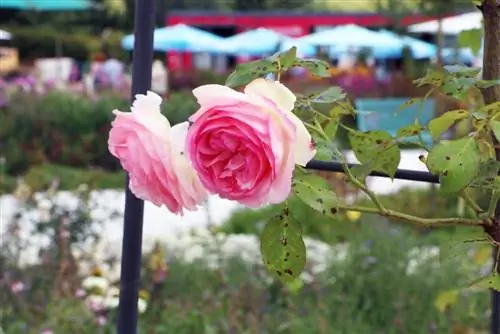- Author admin [email protected].
- Public 2023-12-17 03:39.
- Last modified 2025-06-01 06:48.
When your beloved rose bush suddenly turns brown leaves, panic sets in. Is it a dreaded fungal disease? If yes, which? And above all, what can I do?
Another scenario: The desire for roses in the garden is great! But how often do you hear that roses are very susceptible to pests and diseases. Should you still dare? - Yes, it’s definitely worth it! Because there is a lot that can be done right from the start to keep the risk of illness as low as possible.
Damage images, diagnosis
Unfortunately, there are several fungal diseases that manifest themselves through brown spots on the rose petals. In most cases, there are two fungal diseases that are quite common for roses: black sooty mold and rose rust. Downy mildew also appears somewhat less frequently, initially with brown spots on the leaves.
Star sooty dew
- Infestation visible from April, May
- Infestation of older leaves in the lower area
- spots of different sizes on the tops of the leaves
- Spots round, irregularly shaped
- Stains black-brown
- Stains radiating out at the edge
- Surrounding spots yellow, orange-reddish in color
- the leaves turn yellow in summer
- Leaves fall off
- Assimilation restricted
- Rose is severely weakened
- hardly any new flowers
- Shoots do not ripen
- lower frost hardiness
Rose Rust
- Infestation visible in spring
- Leaf tops show yellowish, rusty red spots
- Spots with dark edges
- Stains turn brownish to black
- Stains merge into one another
- Underside of leaf elongated spore bearings
- Spores first yellow then dark brown
- Leaves fall off
Downy mildew
- Infection visible on the top of the leaf
- dark, violet spots
- Spots usually limited by the leaf veins
- Stains later reddish brown
- Spots on the underside of the leaves brown
- this forms the grayish fungal coating
- Stems also show reddish spots
- Leaves fall off
- Buds drying up
- puny growth
Star sooty dew
Roses are most often attacked by star sooty mold (Diplocarpon rosae). Star sooty mold, also known as black spot disease, is one of the ascomycetes.
The best living conditions for star sooty mold are moist weather, temperatures between 10°C and 15°C and leaf wetness that lasts longer than seven hours.

Until it finds the favorable conditions, it spends the winter in the ground, in the fallen, diseased leaves, in the shoots and buds. The fruiting bodies cannot be seen with the naked eye. They later form the spores, which only spread when they encounter favorable conditions. They may have to wait several years for this. Even temperatures colder than -15°C cannot harm them.
Rose Rust
Rose rust (Phragmidium mucronatum) does not occur quite as regularly as star sooty mildew. It is a so-called parasitic small fungus and belongs to the order of rust fungi. For its life cycle, over the course of infection, it goes through five successive spore forms. It overwinters in infected leaves or twigs.
This fungus finds the best conditions when the leaves are wet for two hours or more and temperatures around 20°C. In spring the spores are spread by the wind.
Downy mildew
The Peronospora sparsa from the order Peronosporales of the egg fungi, grows in the leaf tissue of its host plants. The spores are transmitted through the air and through splash water. It overwinters in the plant as a thick-walled, resistant spore. Downy mildew finds the best conditions in damp, cool weather. This means that a relatively high humidity of 15°C to 20°C is optimal.
Combat
Once you have discovered one of these three fungal diseases on your roses, you should act quickly. It could already be too late for a purely biological defense. If possible, these fungal diseases can only be completely eradicated with fungicides (poisons against fungi). As spores, they are not only invisible, but also so resilient that they can withstand most biological agents. The measures and recipes presented below can be used for all three fungal diseases.
First Aid
- remove affected leaves and plant parts
- dispose of in residual waste
- or burn
- Disinfect rose scissors afterwards (with boiling water, alcohol)
- if necessary, treat with a fungicide (see chemical agents)
- Strengthen rose (see accompanying measures)
Accompanying measures
If there is a fungal infection, the rose itself definitely needs to be strengthened. Similar to sick people, they now need all the support they can get to strengthen their immune system.
- Check the soil: the pH value should be between 5.5 and 7
- If the soil is too acidic, incorporate algae or rock dust
- water regularly with ripe nettle manure (highly diluted)
- Loose the soil and remove weeds
- do not fertilize with nitrogen emphasis
- Rose with horsetail tea cumshot
- otherwise never water from above, always as close to the ground as possible
- clean the soil around the rose thoroughly before and after hibernation
Tip:
If you are familiar with medicinal plants, you can collect comfrey leaves and stems and use them to mulch the soil around the rose to strengthen it.
Chemical agents

If there is an existing fungal infection, only chemical control agents can help. You can find out about the individual remedies in advance from the Federal Office of Consumer Protection and Food Safety. They keep a database of all plant protection products that are also approved for private gardens.
There are different active ingredients, some of which are dangerous to bees, others not. Most of these products also destroy other beneficial insects such as parasitic wasps. It is best if they are not used at all. In any case, you should inform yourself thoroughly before using it or seek advice from a specialist nursery.
Prevention
Preventing fungal diseases is a far more worthwhile, albeit labor-intensive, measure. But especially those who enjoy an ecological natural garden with lots of roses will be successful and, above all, happier with this type of control.
Location
A very important prerequisite for he althy roses is their location. It should be chosen so that there is good air circulation. This allows the leaves to dry quickly after every rain shower. Constantly damp foliage is an invitation for fungal spores.
A sunny location is ideal, but not in a corner protected from the wind. For better ventilation, you should also ensure there is sufficient planting distance from other roses or plants. It is best not to plant a new rose in a location where a rose previously stood. If this cannot be avoided, the soil must be generously replaced.
Tip:
A good pruning also ensures sufficient ventilation of the rose.
Soil, fertilize
The soil should be loamy, humic and permeable, under no circumstances compacted and constantly moist. The roses love a low-acid substrate. Therefore, be careful with nitrogen-based fertilizers. Fast-growing shoots attract aphids.
In general, too many nutrients tend to weaken the rose. It is best to only fertilize with organic fertilizers or compost.
Tip:
A potassium deficiency can be compensated for by natural fertilization with coffee grounds or rhubarb. (Signs of potassium deficiency: flowers remain small, young leaves are slightly reddish)
Strengthen
Nature has a lot of material to offer that can be given to roses to prevent fungal diseases. Some of these can prevent further spread even at the beginning of the infestation. Suggestions for biological prevention against fungal infestation:
Soda
As soon as budding begins, spray the roses with a mixture of water and baking soda for a while, every 14 days.
Recipe
- 10 liters of water
- 50 grams of baking soda
garlic
When the first buds become visible, in May, spread garlic broth on the leaves and especially on the ground. Best every second or third day. Repeat the whole thing at least three times.
Recipe
- 10 liters of water
- 75 grams of garlic
- Roughly chop the cloves and first boil them with a liter of water
- let stand for at least 24 hours
- then strain and dilute
Tip:
Place garlic cloves in the soil around the roses. They are intended to increase the scent and keep the voles away. It would be necessary to test whether this also helps against fungal diseases and aphids.
Milk
A water-milk mixture is also said to help against fungal diseases. At least, as some professional tests have shown, it can stop the infestation. To do this, prepare a mixture in a ratio of 1:10 (milk: water) and proceed as with “baking soda”.
Manures, teas, cold water extracts and broths
Spraying and watering with certain plant preparations is an effective prevention to combat fungal diseases. When heavily diluted in irrigation water, they can also be used as fertilizer. Be careful with comfrey and nettle, they contain a lot of nitrogen.

Treatment to prevent fungal diseases should be carried out every two weeks from April. Cloudy days are best, with light winds so that the leaves can fall off quickly.
Manure
Place fresh or dried plant parts chopped in a container with cold water in the sun. Cover airtight and stir daily. Fermentation should be achieved. Spray fresh manure (bubbles rise) onto the plant in a ratio of 1:50 with water. Suitable: nettle, comfrey.
Tea
Pour boiling water over crushed plants and let them steep for at least 10 minutes. Then use with a 1:10 or 1:20 dilution. For example: garlic, onions.
Cold water extract
For a cold water extract, fresh or dried plant parts are soaked in water for a maximum of three days. Fermentation must not occur. The strained liquid can be used undiluted or in a 1:1 ratio with water. Suitable against fungal diseases: field horsetail, nettle, comfrey
Broth
For a broth, use 1kg of fish or dried plant parts in 10 liters of water. Beforehand, the material is soaked in a little water for a day and then boiled for half an hour. Then cool, strain and dilute with water. This preparation with field horsetail is suitable against fungal diseases.
Tip:
Soaking some tobacco in water for 1-2 days, but without boiling, is also said to stop fungal infestation.
Fungal resistant rose varieties
Last but not least, rather at the very beginning, you can minimize the risk of fungal infections by making sure to buy rose varieties that are as resistant to fungus as possible. The expertise of a relevant nursery can be helpful when purchasing. The ADR seal also identifies very reliably and currently particularly robust rose varieties.
ADR stands for “General German Rose Novelty Test”. This is a panel of experts from the Association of German Nurseries (BdB) and rose growers. They also test new rose varieties to see whether they can survive the three-year test period without pesticides and, of course, without diseases.
Some (few) examples of particularly fungus-resistant, robust rose varieties:
- ‘Heidesommer’ white, Kordes 1985
- ‘Snowflake’ white, Noack 1991, ADR Rose
- Rosa rugosa 'Alba', white, Asian wild rose
- ‘Graham Thomas’, yellow, David Austin 1983
- 'Felicitas', pink, Kordes 1998, ADR Rose
- 'Compass Rose', light pink, Noack 1993, ADR Rose
- ‘The Alexandra Rose’, pink-yellow, David Austin 1992
Conclusion
If you don't want to invest so much time in rose care, but still don't want to miss out on these magnificent, relatively demanding plants, you should definitely choose the right variety when shopping. If an infestation with fungal diseases is detected early in the year, the worst can usually be prevented, even without chemical pesticides. Experience has shown that a light and airy location for the rose is one of the most important prerequisites for protecting it from fungal diseases.

